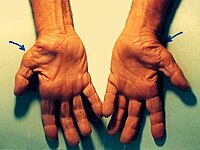
Photo from wikipedia
Inflammatory arthritis frequently affects the wrist, resulting in pain and disability. This study aims to investigate the long-term outcome of patients who underwent posterior interosseous nerve (PIN) denervation for inflammatory… Click to show full abstract
Inflammatory arthritis frequently affects the wrist, resulting in pain and disability. This study aims to investigate the long-term outcome of patients who underwent posterior interosseous nerve (PIN) denervation for inflammatory arthritis of the wrist. xForty consecutive wrists (36 patients) treated with PIN denervation were identified (mean follow-up 47 months; mean age 62.6 years, 77.5% female). Pain and function scores were objectively measured using the patient-rated wrist-evaluation (PRWE) questionnaires. Data was compared for pre-operation and post-operation (early and long term). The Student’s t test was used to compare differences between groups for continuous data, whilst the sign test was utilised for pairwise comparisons. The p value was set at 0.05 for all comparisons. Three patients died during the course of this study from causes unrelated to wrist surgery, resulting in 93% follow-up. PRWE questionnaires demonstrated a significant improvement following PIN denervation (median pain pre-op 42 vs post-op 16 (p < 0.001); median function pre-op 82 vs post-op 41 (p < 0.001), respectively). There were no differences identified between early and long-term post-operative scores. Four cases (10%) had persistent, ulnar-based pain and required secondary salvage wrist arthrodesis. However, 95% of patients remained “very satisfied” or “satisfied” after surgery. This study highlights the effectiveness of PIN denervation as a simple alternative to wrist arthrodesis due to long-term improvement in pain and preservation of function. We recommend this procedure in the presence of a positive diagnostic PIN infiltration test to avoid wrist arthrodesis for as long as possible. In patients with predominantly ulnar-based wrist pain, the outcome is less predictable and this subgroup of patients should be counselled about the possibility of subsequent salvage wrist fusion. Key Points • One of the largest study cohorts which report on the outcome of the wrist PIN denervation procedure with over 2-year follow-up • Clinical outcomes of success are enhanced with the use of validated, objective patient-reported outcome measures relating to overall satisfaction, pain relief and function. • Long-term outcomes are compared to pre-operative and immediate post-operative outcome scores, demonstrating the benefits of PIN denervation and the longevity it provides. Key Points • One of the largest study cohorts which report on the outcome of the wrist PIN denervation procedure with over 2-year follow-up • Clinical outcomes of success are enhanced with the use of validated, objective patient-reported outcome measures relating to overall satisfaction, pain relief and function. • Long-term outcomes are compared to pre-operative and immediate post-operative outcome scores, demonstrating the benefits of PIN denervation and the longevity it provides.
Journal Title: Clinical Rheumatology
Year Published: 2019
Link to full text (if available)
Share on Social Media: Sign Up to like & get
recommendations!